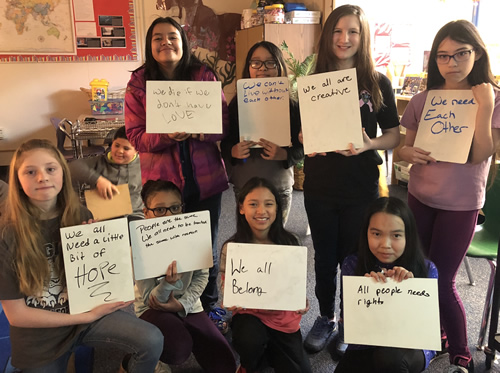At Tudor Elementary School in Anchorage, Alaska, “show and tell” has an inspiring twist.
Instead of sharing an interesting rock or a favorite toy, they are sharing messages of peace and personal commitment to making the world a better place. And, through live video conferencing, they’re sharing their messages with students in Argentina, Pakistan, Brazil, Canada, and the United States, as well as locations throughout Europe, Africa, and Asia.
Tudor’s 346 K-6 students are part of the school’s “Young Global Citizens” project spearheaded by school librarian Michelle Carton, a long-time educator and founder of Global Education Alaska. Carton runs the program, which was recently named the Grand Prize winner in the 2018 Follett Challenge, earning $60,000 in products and services from Follett School Solutions for the way it showcases what it means for her students to be global citizens, how it impacts their learning, their perspectives on the world, and the impacts they can have on it.
As students learn about the world, the United Nations, sustainable development goals, global challenges and opportunities, and how perspectives can be different but honored, they ponder how peace may be different to each other and to people in other parts of the state, the nation, and the world.
Carton developed the project as a way to expose her students to the wider world and to inspire them to really think about what peace means to them personally, what peace means in Alaska, and what peace means to kids in other locations and cultures. Here are some steps for other schools that want to start a program like this.
1. Determine your purpose in setting up a global citizens program. What do you want to achieve by the end of the school year? What’s best for your teaching style and for your students? “I’ve always wanted my students to be able to navigate the interdependent complex world with confidence and an open mind,” says Carton. “Everything I do includes lessons and messages that illustrate how interesting other cultures are and how much we can learn from each other.”
2. Rethink how you teach everything (regardless of subject, math and science included). Think about how you’ll discuss topics with these four things mind: teach students about the world; help them understand and appreciate other perspectives in the world; connect students to the world beyond your town, state, and country; and practice what you preach.
3. Think globally AND act locally. Recycle in your classroom. Use illustrations and examples that feature people who look different and have different names. Celebrate and cite the accomplishments/research of people in small, faraway countries. Go the extra step to find a diverse group of subject-specific heroes. If you do this with young people and engage yourself fully by modeling this behavior, you’ll experience greater growth for all parties.
4. Read books on global education. Carton recommends anything by Homa Tavenger (Growing Up Global: Raising Children to be At Home in the World) and Fernando Reimers (Empowering Students to Improve the World in Sixty Lessons).
5. Find the best global education resources that work for you. Great places to start are Skype in the Classroom, Generation Global, PenPal Schools, and Exploring by the Seat of Your Pants.
6. Use any resources found at Global Education Alaska. Created by Carton, this free website has resources created and curated with the intention of bringing other educators along.
7. Join Google+ Communities that support international project design and connecting classrooms. Some of Carton’s favorites are Connected Classrooms Workshop, Classrooms Without Borders, and Bringing the World into the Classroom.
The outcome for students
The children involved in Carton’s project are seeing how global connecting has affected their learning and their perspective on the world and the impact it has on the world as a whole. By partnering through self-created global projects with hundreds of schools, educators, scientists, activists, and diverse individuals, they are making the change they want to see in the world through their own heartfelt thoughts, ideas, and passions.
“Our students learn communication, critical thinking, creativity, collaboration, and technology skills while they practice empathy, kindness, openness, and compassion,” says Carton. Each child has an opportunity to express how he or she wants to make their mark on the world, pledging to take action in ways that they feel passionate about, from picking up trash, helping others, saving trees, building houses for homeless, or giving and not taking.
“Our kids learn that, at the end of the day, they really aren’t all that different from other kids around the world. They really get that for our world to prosper, we all need to do our part, learn about the challenges and solutions, and take action,” says Carton. “They believe that the future of their world is in their own hands.”
You can learn more about Michelle Carton and her program at Global Education Alaska and follow her on Twitter @AkGlobalTeacher. For more information on entering the Follett Challenge, visit FollettChallenge.
- 4 ways to encourage play in education - April 25, 2024
- CoSN IT Leader Spotlight: Lisa Higgins - April 25, 2024
- It’s time to pay student teachers - April 25, 2024


